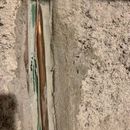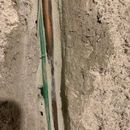Repairing Damaged Spray Foam
I have closed cell spray foam covered with monokote thermal barrier spray in my 100-year old basement in zone 6. It was recently dug into to access the copper pipe (see photos). Now the vapour/thermal barrier is not continuous. Any tips on how best to fix? I know I should have a vapour barrier underneath if I plan to spray over the open cell canned spray. I’ve looked at the 475 building performance products (vana tape, caulk etc), but not sure it will work with my uneven surface and crevices.
Thanks.
GBA Detail Library
A collection of one thousand construction details organized by climate and house part











Replies
Use the really small 12 board foot closed cell spray foam kits Dow makes. Submerge the cans inverted in a bucket of very warm water while spraying to maximize the coverage you get. These small kits are great for repairs like this, and run around $50 or so per kit.
You’ll need to repair the fire retardant separately.
Bill
Thanks, that makes sense.
Are appropriate fire retardants for patching also readily available? Thanks.
Will the closed cell foam surrounding the pipe need to removed so the new spray foam adheres?
And approximately how much? I have the same problem of the closed cell foam separated from joists in many areas of my attic .
No, the new foam will adhere just fine to the old foam. Spray foam is like spray glue, and sticks to just about everything. You won't have any problems with it sticking to stuff. The only thing I'd do as prep is to try to make sure you have removed any large loose chunks, so that the new foam can adhere to a relatively intact base layer. It's like painting over an old wall: remove the peeling paint first so that the new paint sticks to a "good" paint layer. You don't need to do anything fancy.
Bill
Thank You!